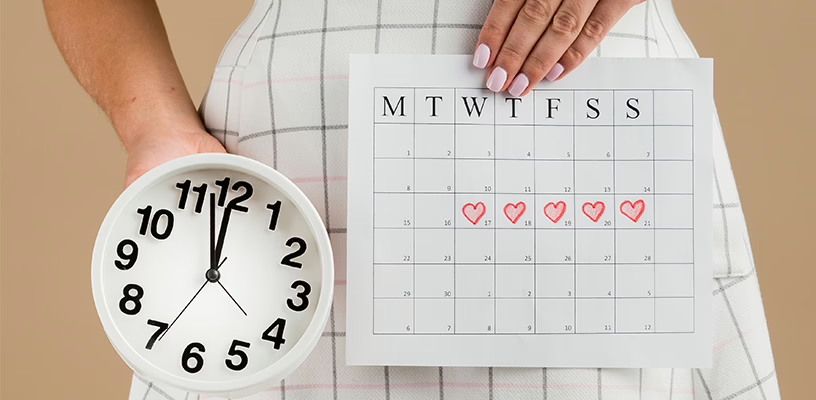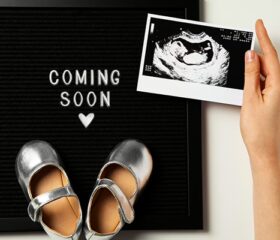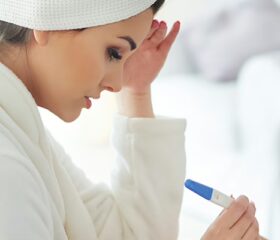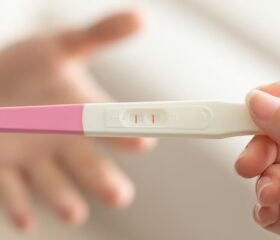Frequently Asked Questions about Ovulation Timing and Conception
Whether you're trying to conceive (or avoid it), calculating ovulation is an important part of knowing when you're most fertile. Here, we answer the most common questions related to ovulation, fertility, and conception.

How do you know when you’re about to ovulate?
You can sometimes tell when you’re about to ovulate by looking out for certain signs in your body. Seeing these doesn’t guarantee it’s about to happen, but they’re suggestive. Watch out for these ovulation symptoms:
Changes in your cervical mucus
Your vaginal discharge (cervical mucus) changes in quantity and consistency throughout your cycle due to your fluctuating hormone levels.
As you approach ovulation each month, your estrogen levels rise, making your mucus clearer, stretchier, and more slippery (the consistency of your discharge may resemble raw egg whites). This ovulation discharge helps sperm travel toward the egg. 16
After ovulation, your mucus returns to normal, becoming thicker, cloudier, and less noticeable.
Changes in your cervical position and texture
It takes some practice to check, but your cervix also changes around ovulation. As you near your fertile period, it tends to move higher in the vagina. It also grows softer to the touch and becomes slightly more open to allow sperm to enter the uterus.
When it returns to a lower, firmer, and more closed state, you can take this as a sign that your ovulation is over. 17
Shifts in your basal body temperature
Your basal body temperature (BBT) is your body’s lowest resting temperature. Some people believe that it fluctuates with your menstrual cycle, which would mean that tracking it on a month-to-month basis could help you figure out when you usually ovulate.
Unfortunately, the scientific evidence for this method is weak, but it’s very popular. If you decide to give it a try, the usual process is to get a special basal thermometer with two decimal points, measure your temperature first thing in the morning (before getting out of bed), and log the number in a journal or a temperature-tracking app.
Proponents of the method claim that in the days leading up to ovulation, your BBT might dip slightly, and when you ovulate, it may increase by about 0.5 degrees Fahrenheit (0.3 degrees Celsius) and remain elevated until your next period. 18 The idea is that over time, you may notice patterns in how your BBT shifts, which will enable you to make an educated guess about when you’ll ovulate.
Again, this method is on questionable scientific footing. Studies have found that the way that women’s menstrual cycles affect their BBTs is variable and unpredictable, making this a poor predictor of ovulation. 19
What’s more, other factors, such as drinking alcohol, smoking, getting a poor night’s sleep, or doing anything in the morning before you take your temperature (including going to the bathroom) can all affect your BBT. 16
If you’re still curious about BBT charting and decide to try it despite its shaky foundations, make sure that you explore it along with other, more reliable methods.
Other symptoms
You might experience additional symptoms around the time you ovulate, such as: 20 21
- Mild pelvic pain in one side (known as “mittelschmerz”) 22
- Light spotting
- Breast tenderness
- Increased libido
- Heightened senses (especially smell and taste) 23
- Bloating
- Tiredness (ovulation fatigue)
All of these symptoms have other possible causes, so if you want to predict your ovulation with more confidence, consider using a home ovulation predictor kit (OPK) or another type of fertility monitor, such as a fertility tracker app. For the best chance at success, use multiple tracking methods simultaneously.
What happens after ovulation?
Once your body releases an egg, it will hang around for 12–24 hours. If a sperm successfully penetrates it, you’ll conceive and become pregnant.
If that doesn’t happen (either because you didn’t have unprotected sex in the days leading up to ovulation or because no viable sperm made it to the egg), you won’t get pregnant. Your uterine lining will shed (you’ll get your period), and your cycle will begin again.
How does conception work?
There are several steps from the moment of conception to when the egg implants in your uterus: 24
Sperm penetrates the egg
If sperm are present in your fallopian tube when the egg arrives, one may successfully penetrate and fertilize it. This moment is when your baby starts to form, and it determines their genetic makeup, including their sex.
The egg starts dividing
After this, the fertilized egg, which is now called a zygote, immediately begins dividing into multiple cells while traveling down the fallopian tube toward your uterus. This journey takes about 3 to 4 days.
The egg implants into your uterus
Once it reaches your uterus, it’s time for implantation. This rapidly growing ball of cells (now called a blastocyst) will attach to your thickened uterine lining. Implantation typically occurs about 6 to 12 days after ovulation.
Your body releases hCG and your pregnancy becomes detectable
If the blastocyst successfully implants into your uterus, your body begins producing the pregnancy hormone hCG. By the time your next period would have been due, you should have a detectable level of hCG in your urine, which will show up if you take a home pregnancy test.
What factors can affect ovulation?
Certain factors can affect the timing of your ovulation or even stop it from happening. For instance, hormonal birth control is designed to prevent it, so it’ll be nearly impossible for you to conceive while taking it.
Other factors that can make you less likely to ovulate regularly (or at all) include: 25
- Stress
- Being overweight or underweight
- Medical conditions like polycystic ovary syndrome (PCOS)
What are the early signs of pregnancy?
While missing your period is often the first noticeable sign that you’re pregnant, you might experience subtle symptoms even before that, potentially within days of conception.
A few of the usual early-pregnancy suspects include: 26
- Breast tenderness
- Implantation bleeding (light spotting)
- Fatigue
- Nausea (morning sickness)
- Increased urination
- Mild cramping or spotting
- Food aversions or cravings
- Headaches
Not all women get these early pregnancy symptoms, so if you don’t have any, that doesn’t mean you’re not pregnant. The reverse is also true: having these symptoms doesn’t prove that you’re pregnant. You’ll need to use pregnancy test strips or a digital test to confirm whether you’ve got a passenger on board.
How can you increase your chances of getting pregnant?
It’s hard to predict how long it’ll take to get pregnant in any given month, but there are ways you can boost your odds (assuming you aren’t struggling with any serious issues affecting your fertility that you need to see a doctor about). Follow these tips:
Time sex well
Sperm can survive for up to five days in your reproductive tract. However, an egg is only viable for about 12–24 hours.
This means that you should try to have sex in the two or three days leading up to ovulation, as well as on the day of ovulation itself. The idea is to have sperm present in the fallopian tube when the egg arrives. To give yourself the best chance, have sex frequently in this period (every day, if possible).
Lead a healthy lifestyle
Maintaining a healthy body mass index (BMI), eating a balanced diet, and getting enough sleep and exercise are all great ways to boost your fertility.
As mentioned earlier, being stressed out can negatively impact your fertility, so if you’re trying to conceive, try to limit stressful activities or at least find a way to relax.
You’ll also want to cut back on your consumption of substances like alcohol and possibly caffeine, although the scientific evidence on the latter is mixed. You should also quit smoking while you’re trying to conceive.27 28 Of course, that isn’t just good advice when you’re trying for a baby—doctors recommend limiting your alcohol intake and avoiding tobacco at all times to protect your health.
Consider your partner’s fertility
It’s not just the mom-to-be that needs to put the work in. Male fertility is also a significant factor in conceiving. Healthy lifestyle choices like quitting smoking, cutting back on alcohol, eating well, and getting enough sleep can all improve a man’s fertility. 29
See a doctor if nothing seems to be working
If you’ve been following all this advice for six months to one year and still haven’t successfully conceived, schedule a preconception appointment with your doctor or fertility specialist to rule out medical issues that may be impacting your fertility (or your partner’s fertility).
Article Sources
- MedlinePlus. "Pregnancy - identifying fertile days" Retrieved April 28, 2025.
- Johns Hopkins Medicine. "Calculating Your Monthly Fertility Window" Retrieved April 28, 2025.
- The New England Journal of Medicine. "Timing of Sexual Intercourse in Relation to Ovulation — Effects on the Probability of Conception, Survival of the Pregnancy, and Sex of the Baby" Retrieved April 28, 2025.
- Demographic Research. "Daily Fecundability" Retrieved April 28, 2025.
- American College of Obstetricians and Gynecologists. "Trying to Get Pregnant? Here’s When to Have Sex" Retrieved April 28, 2025.
- StatPearls. "Physiology, Ovulation" Retrieved April 28, 2025.
- American College of Obstetricians and Gynecologists. "Abnormal Uterine Bleeding" Retrieved April 28, 2025.
- American Pregnancy Association. "How to Track Ovulation With Irregular Periods" Retrieved April 28, 2025.
- Johns Hopkins Medicine. "Menstrual Cycle: An Overview" Retrieved April 28, 2025.
- StatPearls. "Physiology, Menstrual Cycle" Retrieved April 28, 2025.
- Cleveland Clinic. "Follicular Phase" Retrieved April 28, 2025.
- The University of Texas Southwestern Medical Center. "How early can home pregnancy tests show positive results?" Retrieved April 28, 2025.
- Planned Parenthood. "Pregnancy Tests" Retrieved April 28, 2025.
- American College of Obstetricians and Gynecologists. "Methods for Estimating the Due Date" Retrieved April 28, 2025.
- Intermountain Health. "How are Due Dates Calculated?" Retrieved April 28, 2025.
- Penn Medicine Lancaster General Health. "When Do You Ovulate?" Retrieved April 28, 2025.
- Healthline. "Cervix Before Period: How to Identify Changes Throughout Your Menstrual Cycle" Retrieved April 28, 2025.
- MedlinePlus. "Definitions of Health Terms: General Health" Retrieved April 28, 2025.
- Fertility and Sterility. "Accuracy of Basal Body Temperature for Ovulation Detection" Retrieved April 28, 2025.
- Tommy’s. "Ovulation and fertility" Retrieved April 28, 2025.
- WebMD. "Ovulation Symptoms" Retrieved April 28, 2025.
- MedlinePlus. "Mittelschmerz" Retrieved April 28, 2025.
- Healthy Women. "Signs You're Ovulating" Retrieved April 28, 2025.
- University of California San Francisco. "Conception: How It Works" Retrieved April 28, 2025.
- Eunice Kennedy Shriver National Institute of Child Health and Human Development. "What lifestyle and environmental factors may be involved with infertility in females and males?" Retrieved April 28, 2025.
- Eunice Kennedy Shriver National Institute of Child Health and Human Development. "What are some common signs of pregnancy?" Retrieved April 28, 2025.
- MedlinePlus. "Steps to take before you get pregnant" Retrieved April 28, 2025.
- Saudi Medical Journal. "Do caffeine and alcohol affect fertility treatments?" Retrieved April 28, 2025.
- Tommy’s. "How to improve male fertility" Retrieved April 28, 2025.







